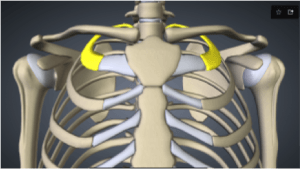The thoracic spine is the segment of a human’s spine in between the cervical (neck) and lumbar spine (lower back). There are 12 thoracic vertebrae normally which each have an attached rib, this forms the rib cage for our internal organs (heart and lungs). There is much mystery surrounding the first rib and its relationship to conditions affecting the cervical spine and the shoulder.

The first rib (top most) is the most curved and usually the shortest of all the ribs and begins from thoracic vertebrae 1 (T1). It articulates with the sternum jut below where the collarbone meets the sternum. It has muscular attachments from the serratus anterior and the anterior scalene.
It is due to the structures that run in-between the first rib and the collarbone that may be compromised by poor first rib mobility and positioning. A common condition seen is Thoracic outlet syndrome, which may have an involvement from the first rib. The brachial plexus (the nerve bundle that sends sensation to the arm and hand) as well as the arteries and veins (subclavian) that feed the arm pass right over the first rib, under the collarbone. Problems begin to arise when the first rib becomes hypo mobile or locked in a raised position. When this happens, the nerves, veins and arteries can become compressed or even crushed between the first rib and the collarbone. This may lead to the patient complaining of pain in the neck, shoulder, or numbness or tingling in the entire upper limb or the forearm and hand. The arm may feel weak or easily fatigued as well. However, sometimes physical signs may be absent.

So what causes the first rib to raise or be hypo mobile? In most cases, it’s due to how you use your body. But in some instances, accidents or injuries to your neck or shoulders can be responsible. The first rib is suspended in place by the scalene muscles at the side of the neck, which tend to pull the rib up, and the intercostal muscles that lie between the ribs have the tendency to pull the rib down. A dynamic balance is needed between these two muscle groups to keep the first rib in its proper place. When the balance is disturbed for some reason, the position of the first rib can shift. The scalene muscles are very strong and they have the ability to pull the first rib up if they shorten for any reason. There are some postural habits that can lead to shortening of these muscles (decreased flexibility), which can cause first rib issues.
It is important to consider how you use your body. We all develop potentially stressful habits of posture, how we sit, how we work etc. When these patterns are repeated enough times the fascia (tissue) in and around the scalene muscles will “help” by becoming thicker, denser and shorter. This can occur with postures such as:
– A forward head posture caused by chronic slouching
– Leaning on your elbow and sinking into the posture
– Holding a phone between your shoulder and ear
– Carrying something with a shoulder strap habitually on the same side.

A physiotherapist can help diagnose and treat you if you have a first rib related issue. Often the first thing to do is change any habit or posture issue that may be contributing to the shortening of the scalene. Reversing the postures previously mentioned, as well as practice carrying a child on either hip and switching frequently can do this. A physiotherapist can also use manual therapies such as mobilisations and massage/dry needling to get the first rib sitting and moving the way it should. So if you’re struggling with neck and shoulder pain and are not getting results from other treatments, consider the first rib as its relevance is huge!


